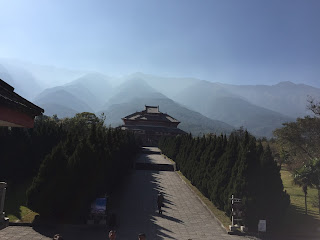We spent our free day traveling to Big Buddha. This involved
public transportation, a cable car, and a hike up a big stair case. Once we got
the Buddha, it was very interesting. Once again, religion was demonstrating,
wealth, impressiveness, and splendor based on the size sheer size of the
statue. These themes were noticeable all throughout China, so I really believe
they contribute to identity. I would also state that the CCP must be in support
of this lifestyle, and prosperity is a part of their platform.
At the
end of the day we made it to the beach, finally. Sitting on the beach was the
most care free I have felt all year. I know that I am not alone when I say that
2016 offered personal challenges for me that tested me like never before.
Having the courage to even go to China in the first place was one of these
challenges. I was really scared, which I know is a natural part of culture
shock. Sitting there on the beach, watching the sun set over the mountains as
the waves crashed to the shore, I felt at peace with myself.
One the
ride back to the hotel after the beach, I started to reflect on the trip
overall. While I truly appreciate the experiences and the new understanding of
the culture, what I was most appreciative of what the reinvigoration of my thirst
to try new things. I have always had a loving of stepping out of comfort zone
for a little while, and I knew that China was going to put this love to the
test. When I came out of it though, I came out with a stronger, deeper love for
the unknown. Chinese culture is really something to behold and revere. I gained
such a respect for their way of life. I understand that my ethnocentrism was a
tangible part of who I used to be before this trip. On my quest to discover
Chinese identity, I also redefined myself. While I will always have an
appreciation and love of political science, sometimes taking the politics out
of a situation can leave room for culture and heritage. I plan to carry this
experience with me for the rest of my life.

























